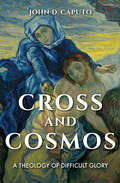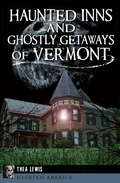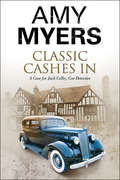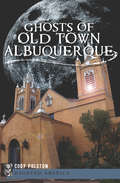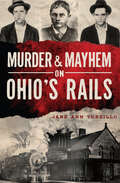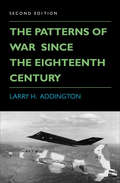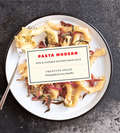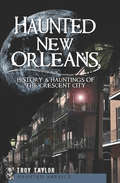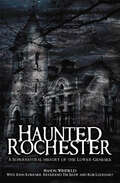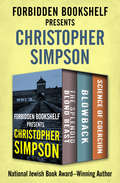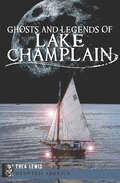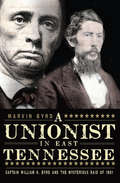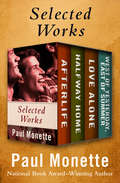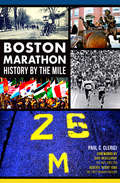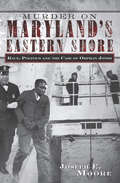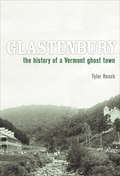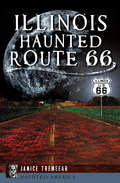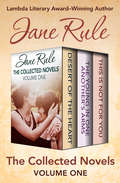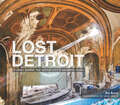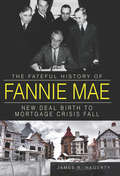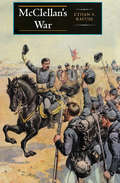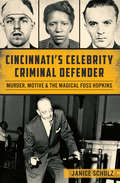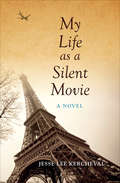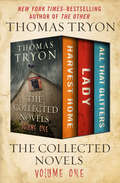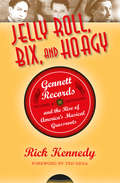- Table View
- List View
Cross and Cosmos: A Theology of Difficult Glory (Indiana Series in the Philosophy of Religion)
by John D. CaputoThe renowned theologian &“brings Luther and cosmology into dialogue with radical theological movements that have their point of departure in deconstruction&” (George Pattison, author of Eternal God/Saving Time). John D. Caputo stretches his project as a radical theologian to new limits in this groundbreaking book. Mapping out his summative theological position, he identifies with Martin Luther to take on notions of the hidden god, the theology of the cross, confessional theology, and natural theology. Caputo also confronts the dark side of the cross with its correlation to lynching and racial and sexual discrimination. Caputo is clear that he is not writing as any kind of orthodox Lutheran but is instead engaging with a radical view of theology, cosmology, and poetics of the cross. Readers will recognize Caputo&’s signature themes—hermeneutics, deconstruction, weakness, and the call—as well as his unique voice as he writes about moral life and our strivings for joy against contemporary society and politics. &“This work will be eagerly awaited and immediately read by John D. Caputo&’s many followers. They will be looking for him to fill out the &‘big picture&’ which makes manifest for the first time all the parts and pieces he has contributed to the theological project he launched early in the previous decade.&” —Carl Raschke, author of Postmodern Theology &“Caputo is always distinctive.&” —George Pattison, author of Eternal God/Saving Time
Haunted Inns and Ghostly Getaways of Vermont (Haunted America)
by Thea LewisPrepare to be disturbed by the preternatural guests at the Green Mountain State&’s most creeptastic lodgings—from the author of Haunted Burlington. Creaks and groans in the night remind guests that they might not be alone in Vermont&’s inns. Discover the history behind some of the Green Mountain State&’s spookiest places to spend the night. Loyal guest Mary Todd Lincoln enjoyed her annual respites at the Equinox Hotel in Manchester so much that death could not interrupt the tradition. Some still feel the presence of Al Capone in the underground bar he favored at Highgate Manor. The show goes on for the ghost of tap-dancing hero Boots Berry at Stowe&’s Green Mountain Inn. Queen City Ghostwalk creator and author Thea Lewis shares chilling encounters and examines the spirits of the past that are not quite resting in peace. Haunted Inns and Ghostly Getaways of Vermont is the only bedtime story for a night in Vermont&’s eerie lodgings. Includes photos! &“For Lewis, a gifted storyteller, a good story makes a haunted place all the more compelling.&” —Happy Vermont
Classic Cashes In: A British Classic Car Mystery (The Jack Colby, Car Detective Mysteries #6)
by Amy MyersA British car detective steers a &’36 Packard straight into a deadly world of elite family secrets in a series &“very much in the tradition of Dick Francis&” (Kirkus Reviews). Philip Moxton, a wealthy banker in the west of Kent, is anything but a routine client for Jack Colby, freelance investigator for the Kent police car-theft unit. Moxton is desperate for a very particular 1936 Packard One-Twenty saloon. Once, he was obliged to sell it. Now he wants to buy it back—anonymously, at any price, and soon. Because as Moxton tells it, he&’s going to be murdered. The case stalls when Colby tracks down the current owner, actor Tom Herrick. Herrick knows why Moxton wants to get his hands on it—a mystery involving an ongoing Moxton-Herrick family feud, and a multi-million-dollar legacy. For Colby, the search for the truth becomes treacherous as a relentless killer gears up to strike again and again. Everyone in the shadow of the prized Packard is a suspect. And anyone could be the next victim.
Ghosts of Old Town Albuquerque (Haunted America)
by Cody PolstonMeet the spirits who haunt this historic New Mexico city . . . photos included! Old Town Plaza has been the center of Albuquerque community life since the city was founded in 1706 by Gov. Francisco Cuervo y Valdez. Historically known as the crossroads of the Southwest, and reflecting an amalgamation of Spanish, Mexican, and Native American cultures, Old Town Plaza has been home to many of New Mexico&’s proud ancestors—and still is. Ghosts of Old Town Albuquerque presents the evidence of their specters wandering the shadows, gathered by author Cody Polston, president of the Southwest Ghost Hunter&’s Association. Having tracked spirits for three decades, including in such landmarks as the Bottger Mansion and Casa de Ruiz, Polston explores the history and mysteries behind many of Old Town Plaza&’s eerie wraiths.
Murder & Mayhem on Ohio's Rails (Murder And Mayhem Ser.)
by Jane Ann TurzilloAll aboard for a breakneck trip into history, as the author of Wicked Women of Ohio details the Buckeye State&’s most daring train holdups. Ride Ohio&’s rails with some of the bravest trainmen and most vicious killers and robbers to ever roll down the tracks. The West may have had Jesse James and Butch Cassidy, but Ohio had its own brand of train robbers. Discover how Alvin Karpis knocked off an Erie Railroad train and escaped with $34,000. Learn about the first peacetime train holdup that took place in North Bend when thieves derailed the Kate Jackson, robbed its passengers and blew the Adam&’s Express safe. Make no mistake—railroading was a dangerous job in bygone days. Includes photos! &“Ohio was plagued by train bandits, too, and some of them were shockingly violent. Journalist Jane Ann Turzillo has researched 10 interesting cases for her book.&” —Akron Beacon Journal
The Patterns of War Since the Eighteenth Century
by Larry H. Addington&“This important work . . . synthesizes the evolution of warfare from 1775 to the present.&” —Military Review A thorough revision of a highly successful text, the second edition of this classic work provides a comprehensive picture of the evolution of modern warfare. Addington discusses developments in strategies and tactics, logistics and weaponry, and provides detailed discussions of important battles and campaigns. His book is an excellent introduction for both students and the general reader. &“There is nothing else in print that tells so much so concisely about how war has been conducted since the days of General George Washington.&” —Russell F. Weigley, author of The American Way of War &“A superior synthesis. Well written, nicely organized, remarkably comprehensive, and laced with facts.&” —Military Affairs
Pasta Modern: New & Inspired Recipes from Italy
by Francine SeganA palate-pleasing cookbook that &“enables us to virtually visit Italy&’s 20 regions and savor its pastas&” (Booklist, starred review). In Pasta Modern, Italian food authority Francine Segan challenges the notion that pasta must be traditional or old-world. In this beautifully photographed cookbook, Segan details the hottest, newest, and most unusual pasta dishes from Italy&’s food bloggers, home cooks, artisan pasta makers, and vanguard chefs. The one hundred distinctive pasta recipes, including many vegan and vegetarian specialties, range from simple and elegant (Pasta with Caramelized Oranges) to more complex (Neapolitan Carnevale Lasagna) to cutting-edge (Cappuccino-Caper Pasta). Tips and anecdotes culled from Segan&’s Italian travels enhance the easy-to-follow directions, and a glossary of more than fifty extraordinary dried pastas showcases shapes to revive any pasta lover&’s repertoire. For contemporary, authentic Italian pasta, Pasta Modern is the go-to guide.
Haunted New Orleans: History & Hauntings of the Crescent City (Haunted America)
by Troy TaylorTravel beyond Bourbon Street into the macabre history of one of the most haunted cities in the United States with the author of Wicked New Orleans as your guide. New Orleans—the Big Easy, the birthplace of jazz, home of Cafe du Monde and what some call the most haunted city in America. Beneath the indulgence and revelry of the Crescent City lies a long history of the dark and mysterious. From the famous &“Queen of Voodoo,&” Marie Laveau, who is said to haunt the site of her grave, to the wicked LaLauries, whose true natures were hidden behind elegance and the trappings of high society, New Orleans is filled with spirits of all kinds. Some of the ghosts in these stories have sordid and scandalous histories, while others are friendly specters who simply can&’t leave their beloved city behind. Join supernatural historian Troy Taylor as he takes readers beyond the French Quarter and shows a side of New Orleans never seen. Includes photos!
Haunted Rochester: A Supernatural History of the Lower Genesee (Haunted America Ser.)
by Mason Winfield Rob Lockhart John Koerner Reverend Tim ShawThe western New York state Great Lakes region serves as a scenic setting for supernatural traditions, incidences, and folklore. Avenging specters, demon-tortured roads, holy miracles, weird psychic events, prehistoric power sites, ancient curses, Native American shamans, active battlefields, ghost ships, black dogs, haunted monuments, and the phantoms of Rochester&’s famous—all are part of the legacy of Rochester and the lower Genesee. Supernatural historian Mason Winfield and the research team from Haunted History Ghost Walks, Inc., take us on a spiritual safari through the Seneca homeland of the &“Sweet River Valley&” and the modern city in its place. After their survey of Rochester&’s super natural history and tradition, &“the Flour City&” will never look the same. Includes photos!
Forbidden Bookshelf Presents Christopher Simpson: The Splendid Blond Beast, Blowback, and Science of Coercion (Forbidden Bookshelf)
by Christopher SimpsonThree provocative exposés from a National Jewish Book Award–winning journalist address the CIA&’s recruitment of Nazis and use of psychological warfare. The Splendid Blond Beast: This groundbreaking investigation into the CIA&’s post–World War II liberation and recruitment of Nazi war criminals—including the pivotal role played by CIA director Allen Dulles—traces the roots not only of US government malfeasance, but of mass murder as an instrument of financial gain and state power, from the Armenian genocide during World War I to Hitler&’s Holocaust through the practice of genocide today. &“Revelatory and shocking.&” —Kirkus Reviews Blowback: The true story of how US intelligence organizations employed Nazi war criminals in clandestine warfare and propaganda against the USSR, anticolonial revolutionaries, and progressive movements worldwide that were claimed to be Soviet pawns. &“The story is one that needs to be told, and Blowback makes a major contribution to its telling, supplementing a thorough collation of known cases with ample new research.&” —The New York Times Science of Coercion: Drawing on long-classified documents from the Pentagon, the CIA, and other national security agencies, Simpson exposes secret government-funded research into psychological warfare and reveals that many of the most respected pioneers in the field of communication science were knowingly complicit as their findings were employed for the purposes of propaganda, subversion, intimidation, and counterinsurgency during the Cold War era. &“An intriguing picture of the relations between state power and the intellectual community.&” —Noam Chomsky, Massachusetts Institute of Technology
Ghosts and Legends of Lake Champlain (Haunted America)
by Thea LewisThe author of Haunted Burlington shares Lake Champlain&’s chilling history—from swashbuckling spirits to Champ, &“North America&’s Loch Ness Monster.&” Lake Champlain is located between New York&’s majestic Adirondacks and Vermont&’s famed Green Mountains. Yet despite the beauty of this region, it has been the site of dark and mysterious events; it is not surprising that some spirits linger in this otherwise tranquil place. Fort Ticonderoga saw some of early America&’s bloodiest battles, and American, French and British ghosts still stand guard. A spirit walks the halls of SUNY Plattsburgh, even after his original haunt burned in 1929. Champlain&’s islands—Stave, Crab, Valcour and Garden—all host otherworldly inhabitants, and unidentified creatures and objects have made appearances on the water, in the sky and in the forests surrounding the lake. Join Burlington&’s Thea Lewis as she explores the ghosts and legends that haunt Lake Champlain. Includes photos! &“For Lewis, a gifted storyteller, a good story makes a haunted place all the more compelling.&” —Happy Vermont
A Unionist in East Tennessee: Captain William K. Byrd and the Mysterious Raid of 1861 (Civil War Ser.)
by Marvin ByrdThe Civil War that tore America in two also pit one Tennessean against another—with deadly consequences . . . During the Civil War, Tennessee was perhaps the most conflicted state in the Confederacy. Allegiance to either side could mean life or death, as Union militia captain and longtime Tennessee resident William K. Byrd discovered in the fall of 1861 when he and his men were attacked by a band of Confederate sympathizers and infantrymen. This unauthorized raid led to the arrest of thirty-five men and the death of several others. Details of this mysterious skirmish have remained buried in archives and personal accounts for years. Now, for the first time, A Unionist in East Tennessee uncovers a dramatic yet forgotten chapter of Civil War history. Includes photos! &“The author does a fine job of communicating the charged political atmosphere in 1861, in isolated Hawkins and Hancock counties and in East Tennessee at large . . . [He] constructs a strong case that the planning and conduct of the raid was a local affair not ordered by Confederate military authorities.&” —Civil War Books and Authors
Selected Works: Afterlife; Halfway Home; Love Alone; and West of Yesterday, East of Summer
by Paul MonetteTwo novels and two collections of poetry, all powerful reflections on the AIDS experience, from the National Book Award–winning author of Becoming a Man. Afterlife: Three men bond after their lovers die of AIDS, all within a week of one another in the same Los Angeles hospital. Each of the men react differently to the situation he&’s in, but no matter the path each takes, they are all searching for a way to live and love again. Halfway Home: After being diagnosed with AIDS, Tom moves to a California beach house to live out the rest of his life in peace. But the unexpected reappearance of his troubled brother quickly changes everything in this novel about anger, reconciliation, love, and danger. Love Alone: Following his partner Roger Horwitz&’s death from AIDS in 1986, Paul Monette threw himself into these elegies. Writing them, he says, &“quite literally kept me alive.&” Both beautifully written and deeply affecting, every poem is full of resentment, sorrow, tenderness, and a palpable sense of grief—but also love. West of Yesterday, East of Summer: This stunning career-spanning collection includes Monette&’s early work as well as the beautiful and wrenching poems borne out of immense loss. Written with characteristic wit, these poems deftly traverse humor, rage, love, and mourning.
Boston Marathon: History by the Mile (Sports Ser.)
by Paul C. Clerici&“Clerici brings the race to life through . . . stories about every statue, landmark and portion of the course from its start in 1897 to its current incarnation&” (MetroWest Daily News). From Hopkinton to Boylston Street, the beloved 26.2 miles of the Boston Marathon mark historic moments and memories dating back to 1897. Town by town and step by step, follow author, journalist, and runner Paul C. Clerici as he goes deeper into each town and city along the route with firsthand descriptions of the course from the uphill climbs to the spirited sprints. Insightful anecdotes, from the naming of Heartbreak Hill to the incorporation of women runners, reveal meaningful racing heritage along the route. This comprehensive and unique journey also explores the stories behind notable landmarks, statues, and mile markers throughout the course. Woven into the course history is expert advice on how to run each leg of the race from renowned running coach Bill Squires. Whether you&’re a runner, spectator, or fan, Boston Marathon: History by the Mile has it all. Includes photos!
Murder on Maryland's Eastern Shore: Race, Politics and the Case of Orphan Jones (True Crime Ser.)
by Joseph E. MooreFrom a former Maryland attorney comes the true crime story of accused murderer Orphan Jones—a case mired in the racism and politics of 1930s America. Euel Lee, alias Orphan Jones, was an African American accused of murdering his white employer and family over a single dollar. The tumultuous events and cast of characters surrounding the racially charged crime garnered national media attention and changed the course of Maryland history. With exacting research, former Maryland State&’s Attorney Joseph E. Moore reconstructs the murders, the ensuing roller coast of a trial, and the eventual conviction and execution of Orphan Jones. Moore details all of this in the context of Jim Crow politics and American society during the Great Depression in this gripping true crime account. &“The Euel Lee case as explored by Joe Moore is more than good, readable, local history. It is about the stresses and strains in American society in the Depression, from the radicalism of a young Communist lawyer to the conscious efforts of a rural community to contain violence, confront or at least deal with their prejudices and see that justice was served for a senseless murder in their midst. Moore sets a high standard of factual accountability and entertaining narrative based upon oral history and archival research. General readers and scholars alike will not be disappointed.&” —Edward C. Papenfuse, PhD, Maryland State Archivist and Commissioner of Land Patents
Glastenbury: The History of a Vermont Ghost Town (Brief History Ser.)
by Tyler ReschThe curious history of a tiny town that all but disappeared . . . Includes photos! Founded by a famously scheming New Hampshire governor, Glastenbury struggled for over a century to break triple digits in population. A small charcoal-making industry briefly flourished after the Civil War, yet by 1920 Glastenbury counted fewer than twenty inhabitants. The end came officially in 1937, when the state, following a spirited debate, formally disincorporated the town. Yet Glastenbury&’s legacy lives on in Tyler Resch&’s lively and amusing history. Follow Resch as he chronicles the community&’s compelling, if always precarious, existence. From mysterious murders and curious development schemes to the township&’s eventual annexation by the US Forest Service, Glastenbury tells the ultimately redemptive tale of a community that lost its political status, only to gain a national forest.
Illinois Haunted Route 66 (Haunted America)
by Janice TremeearThere&’s no detour from terror on this creepy thrill ride down part of America&’s historic highway—from the author of Haunted Ozarks. Route 66 is no longer the main thoroughfare between Chicago and St. Louis, but if local lore is to be believed, ghostly traffic along the Mother Road continues unabated. Janice Tremeear chases down accounts of a man executed for witchcraft, the demon baby of Hull House, and the secrets of H. H. Holmes&’s &“Murder Castle.&” Native American legends place the piasa bird in the skies above the highway&’s southern stretch with the same insistence that characterize contemporary UFO sightings in the North. In between, spirits such as Resurrection Mary join the throng of hapless souls wandering the roadside of the Prairie State&’s most famous byway.
The Collected Novels Volume One: Desert of the Heart, The Young in One Another's Arms, and This Is Not for You
by Jane RuleThree beautiful novels from the groundbreaking, award-winning author—including &“a landmark work of lesbian fiction&” and basis for the film Desert Hearts (The New York Times). First published in 1964, Desert of the Heart broke ground with its realistic and complex portrayal of love between two women, and immediately established Jane Rule&’s reputation as an &“extraordinary writer—perhaps the most significant lesbian fiction writer of the twentieth century&” (Katherine V. Forrest). Desert of the Heart: Rule&’s debut novel is set in 1950s Reno, Nevada, where English professor Evelyn Hall has come for a quick divorce from her husband. There she meets Ann Childs, fifteen years her junior, who works as a change apron in a casino. As their friendship deepens into a romantic relationship, Evelyn&’s preconceptions about love, morality, and identity are challenged. &“An intelligent and utterly believable novel.&” —Joyce Carol Oates The Young in One Another&’s Arms: In Ruth Wheeler&’s Vancouver rooming house during the Vietnam War, an eclectic assortment of misfits, dropouts, deserters, and radicals become each other&’s chosen family. When developers threaten the property, the community is challenged to find a new home on Galiano Island. &“[A] mature and satisfying work.&” —Bay Area Reporter This Is Not for You: Through a decades-long correspondence between Katherine and Esther, the woman with whom she falls passionately in love, Rule&’s second novel follows a group of friends living in New York and abroad as they explore the freedoms—and limitations—of their sexuality, as the repressed fifties gives way to the liberated sixties. &“A beautiful, ironic, civilized novel.&” —Margaret Lawrence
Lost Detroit: Stories Behind the Motor City's Majestic Ruins (Lost Ser.)
by Dan AustinStories and photographs celebrating the city&’s history through its abandoned architectural landmarks. Lost Detroit tells the stories behind twelve of the city&’s most beautiful left-behind landmarks and of the people who occupied them, from the day they opened to the day they closed. While these buildings might stand as ghosts of the past today, their stories live on within these pages. This book brings you the memories of those who caught trains out of the majestic Michigan Central Station, necked with girlfriends in the balcony of the palatial Michigan Theatre, danced the night away at the Vanity Ballroom, and kicked out the jams at the Grande Ballroom. Filled with stunning and often moving photographs, it&’s a treasure for history and architecture buffs, as well as for native Detroiters. &“A fascinating journey.&” —John Gallagher, Detroit Free Press architecture critic, from the Foreword
The Fateful History of Fannie Mae: New Deal Birth to Mortgage Crisis Fall
by James R. Hagerty&“A lucid and meticulously reported book by one of the Wall Street Journal&’s ace reporters&” (George Anders, Forbes contributor and author of The Rare Find). In 1938, the administration of Franklin Delano Roosevelt created a small agency called Fannie Mae. Intended to make home loans more accessible, the agency was born of the Great Depression and a government desperate to revive housing construction. It was a minor detail of the New Deal, barely recorded by the newspapers of the day. Over the next seventy years, Fannie Mae evolved into one of the largest financial companies in the world, owned by private shareholders but with its nearly $1 trillion of debt effectively guaranteed by the government. Almost from the beginning, critics repeatedly warned that Fannie was an accident waiting to happen. Then, in 2008, the housing market collapsed. Amid a wave of foreclosures, the company&’s capital began to run out, and the US Treasury seized control. From the New Deal to President Obama&’s administration, James R. Hagerty explains this fascinating but little-understood saga. Based on the author&’s reporting for the Wall Street Journal, personal research, and interviews with executives, regulators, and congressional leaders, The Fateful History of Fannie Mae, he explains the politics, economics, and human frailties behind seven decades of missed opportunities to prevent a financial disaster.
McClellan's War: The Failure Of Moderation In The Struggle For The Union
by Ethan S. Rafuse&“An important book that rescues George B. McClellan&’s military reputation.&” —Chronicles Bold, brash, and full of ambition, George Brinton McClellan seemed destined for greatness when he assumed command of all the Union armies before he was 35. It was not to be. Ultimately deemed a failure on the battlefield by Abraham Lincoln, he was finally dismissed from command following the bloody battle of Antietam. To better understand this fascinating, however flawed, character, Ethan S. Rafuse considers the broad and complicated political climate of the earlier 19th Century. Rather than blaming McClellan for the Union&’s military losses, Rafuse attempts to understand his political thinking as it affected his wartime strategy. As a result, Rafuse sheds light not only on McClellan&’s conduct on the battlefields of 1861-62 but also on United States politics and culture in the years leading up to the Civil War. &“Any historian seriously interested in the period will come away from the book with useful material and a better understanding of George B. McClellan.&” —Journal of Southern History &“Exhaustively researched and lucidly written, Rafuse has done an excellent job in giving us a different perspective on &‘Little Mac.&’&” —Civil War History &“Rafuse&’s thoughtful study of Little Mac shows just how enthralling this complex and flawed individual continues to be.&” —Blue & Gray magazine
Cincinnati's Celebrity Criminal Defender: Murder, Motive & the Magical Foss Hopkins
by Janice SchulzMurder, deceit, and thrilling courtroom drama in this chronicle of Ohio&’s infamous criminal defense attorney, Foss Hopkins. With half a century in the courtroom, criminal defense attorney William &“Foss&” Hopkins represented more than 550 clients. Known to be charismatic and brilliant, Foss&’s dedication to defending the falsely accused often landed him in controversy. He specialized murder cases, and took on had more than a few colorful defendants . . . William Kuhlman and his gang left a trail of blood from Indiana to Kentucky after hacking up the body of Cincinnati fireman &“Cap&” Miller. Attractive and naïve Louise Sharpe pumped three bullets into her lover and left him dying on the floor of his Walnut Hills apartment. After Marie Abbott&’s farmhand lover killed her husband, Marie helped him stage the murder as an accident . . . These are just some of the people whose trials made Foss Hopkins Cincinnati&’s Celebrity Criminal Defender. In this captivating book you&’ll learn about the man himself, some of his most astounding victories, and the crushing defeats that ended in the electric chair.
My Life as a Silent Movie: A Novel (Break Away Bks.)
by Jesse Lee KerchevalAfter a tragic loss, an American woman investigates her birth family in Paris: &“The novel&’s twists and turns are wonderfully unexpected&” (Emma Straub, author of Modern Lovers). In her early forties, Emma has recently lost her husband and daughter to a tragic auto accident. When her elderly aunt visits her Indiana home to provide comfort, and instead blurts out the news that Emma was adopted, a new kind of shock sets in. Soon, a still-mourning Emma finds herself flying to Paris, where she will discover the twin brother whose existence she never knew about, and the identity of her birth parents—a White Russian film star of the 1920s and a French Stalinist. A story about identity and the relationship between art and life, My Life as a Silent Movie is &“a beautiful, evocative novel [that] melds the magic of old movies with the redemptive power of family&” (Jonis Agee, author of The Bones of Paradise). &“In this sharply drawn chronicle of grief, a woman reassembles her identity through her father&’s art and her brother&’s tenuous offer of a new life . . . Kercheval delves deeply into the rawest of emotions and the most wrenching of choices, richly detailing each twist and turn with grace.&” —Kirkus Reviews
The Collected Novels Volume One: Harvest Home, Lady, All That Glitters
by Thomas TryonFrom horror to Hollywood, three haunting novels from the New York Times–bestselling author of Crowned Heads and The Other. Harvest Home: After escaping New York City for the idyllic New England village of Cornwall Coombe, the Constantine family wins the friendship of the town matriarch, the mysterious Widow Fortune, who invites them to join the ancient festival of Harvest Home. But something far more sinister than the annual harvest is about to rise out of the earth in this New York Times bestseller. &“[A] brilliantly imagined horror story.&” —The Boston Globe Lady: In the town of Pequot Landing during the Great Depression, a young man becomes transfixed by a beautiful, mysterious widow. As Woody gets closer to her, he finds that Lady Harleigh is haunted—not just by grief, but by a scandalous secret that, if revealed, could change Pequot Landing forever. Lady is a New York Times bestseller. &“A spellbinder with a twisted ending . . . enchanting entertainment. You can&’t put it down.&” —The Des Moines Register All That Glitters: In five interlocking novellas, cynical writer Charlie Caine recalls the leading ladies of long-lost Hollywood: Babe, a red-hot, peroxide-blond beauty with secrets that could have burned Tinseltown to the ground; Belinda, whose daughter was as cruel as she was lovely; Claire, who would do anything to stay in the public eye; April, fragile, beautiful, and mad; and Maude, Hollywood&’s most respected matron, whose happy marriage had a lie at its heart. &“One unforgettable novel with the power to shock . . . very believable . . . [readers] will find pleasure in guessing which real-life actresses Tryon has used as models.&” —The Washington Post
Jelly Roll, Bix, and Hoagy: Gennett Records and the Rise of America's Musical Grassroots
by Rick Kennedy&“A lively and anecdotal history&” of the tiny family-run studio where jazz greats from Jelly Roll Morton to Louis Armstrong made their first recordings (Jazz Times). From 1917 to 1932, in a primitive studio next to the railroad tracks, the Gennett family of Richmond, Indiana, recorded some of the earliest performances of jazz, blues, and country greats—including Jelly Roll Morton, Big Bill Broonzy, King Oliver, Louis Armstrong, Gene Autry, Bix Beiderbecke, and native Hoosier Hoagy Carmichael (whose &“Stardust&” debuted on Gennett as a dance stomp). Jelly Roll, Bix, and Hoagy is the first thoroughly researched account of the people and events behind this unique company and its outsized impact on American music. Alive with personal details and anecdotes from musicians, employees, and family members, it traces the colorful history of a pioneer recording company.
